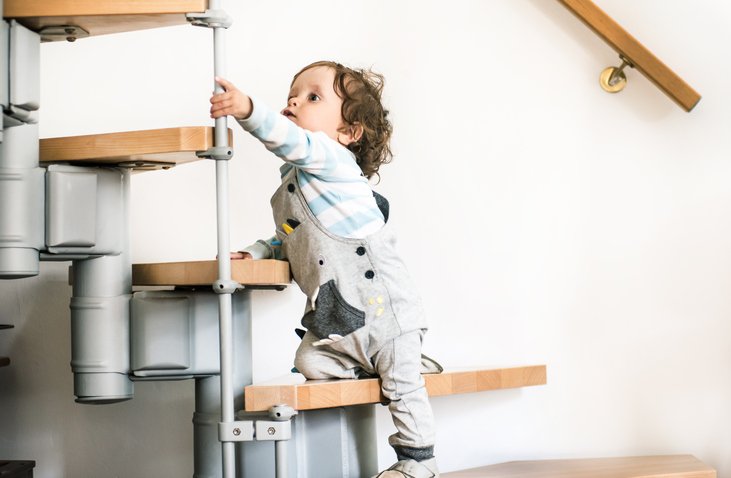Climbing is a skill that children reach incrementally. While some toddlers seem hardwired to climb absolutely everything in sight, others are content to sit and watch the world go by. Some toddlers might even appear fearful, or overly cautious, about climbing.
Climbing often begins with crawling over objects in their path, progresses to climbing onto furniture or attempting to crawl upstairs, and is mastered when children can climb up and down stairs using alternate feet without assistance. The age at which this occurs varies and can be influenced by environmental factors.
Crawling
Crawling is the first motor developmental milestone young children reach. Children typically begin crawling sometime between 6 and 9 months, though some babies begin crawling later. One your baby is mobile, he’ll begin crawling over obstacles in his path. Whether he encounters toys left around the floor or soft pillows strategically placed to encourage motor coordination, climbing up and over small objects is the first step toward mastering climbing skills.
Walking
Most young movers begin pulling themselves up on objects to get to a standing position between 9 and 12 months. This requires coordinating arm movements with leg movements, and assists with muscle development. Some toddlers enjoy pulling up on furniture so much that they seem to spend much of their time trying to climb up on everything in the room!
This is also the time when many children begin walking with assistance. Once toddlers master walking with assistance, they begin to steps independently. Once this task is mastered, the real climbing begins. Be sure to scan your house for areas to babyproof because new walkers tend to attempt to climb on stools, chairs, and any other objects they might encounter.
Climbing stairs
Stair climbing is a difficult skill to master, but that doesn’t stop babies and toddlers from giving it a try. Some babies are drawn to stairs as young as six months (though they are typically not coordinated enough to climb stairs without falling), while others wait until they have better balance and muscle control.
By about 15-16 months, toddlers begin to walk up stairs with adult assistance. By age two, toddlers attempt to walk up stairs using handrails. The final stage of climbing stairs occurs between 2 and 3 years old, when most toddlers can walk down stairs independently. By age three, most toddlers can walk down stairs alternating their feet.
Advanced climbing
Advanced climbing, like attempting the climbing bridge at the tot lot, requires adequate balance, coordination, and muscle strength. Active children who spend a lot of time outdoors and practicing climbing are able to tackle climbing ladders between 3 and 4 years, but advanced climbing skills aren’t fully developed until much later.
How to promote climbing skills:
Environment plays an important role in developing climbing skills. Active kids with active parents who give their kids the time and space to work on balance and muscle development are likely to climb earlier. Try these strategies to encourage safe climbing skills:
• Make sure your play area is safe for climbers. Bolt heavy furniture to the wall and move low furniture away from windows.
• Encourage your toddler to walk on a variety of surfaces to help your toddler learn to navigate different terrain. Try grass, sand, pavement, wood chips, and a variety of indoor surfaces.
• Visit different parks and playgrounds to test new skills.
• Create indoor obstacle courses with soft pillows and other manageable objects to encourage your toddler to practice going up and over.
A climbing toddler can cause parents to worry about safety. The best way to empower your child to engage in safe climbing play is to teach him how to use his strength and coordination to navigate obstacles. While bumps and bruises are natural during the toddler years, young children can learn to climb and take healthy risks while staying safe from injury.
